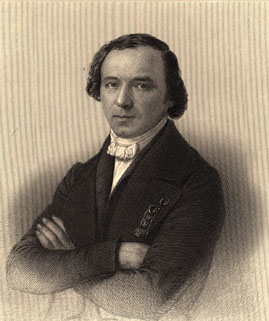| Jean-Baptiste-André Dumas  Born: 14-Jul-1800 Born: 14-Jul-1800
Birthplace: Alais, France
Died: 10-Apr-1884
Location of death: Cannes, France
Cause of death: unspecified
Gender: Male
Race or Ethnicity: White
Occupation: Chemist Nationality: France
Executive summary: Pioneer of organic chemistry French chemist, was born at Alais (Gard) on the 15th of July 1800. Disappointed in his early hope of entering the navy, he became apprentice to an apothecary in his native town; but seeing little prospect of advancement in that calling, he soon moved to Geneva (1816). There he attended the lectures of such men as M. A. Pictet in physics, C. G. de la Rive in chemistry, and A. P. de Candolle in botany, and before he had reached his majority he was engaged with Pierre Prévost in original work on problems of physiological chemistry, and even of embryology. In 1823, acting on the advice of A. von Humboldt, he left Geneva for Paris, which he made his home for the rest of his life. There he gained the acquaintance of many of the foremost scientific men of the day, and quickly made a name for himself both as a teacher and an investigator, attaining within ten years the honor of membership of the Academy of Sciences. When approaching his fiftieth year he entered political life, and became a member of the National Legislative Assembly. He acted as minister of agriculture and commerce for a few months in 1850-51, and subsequently became a senator, president of the municipal council of Paris, and master of the French mint; but his official career came to a sudden end with the fall of the Second Empire. He died at Cannes on the 11th of April 1884. Dumas is one of the most prominent figures in the chemical history of the middle part of the 19th century. He was one of the first to criticize the electro-chemical doctrines of Berzelius, which at the time his work began were widely accepted as the true theory of the constitution of compound bodies, and opposed a unitary view to the dualistic conception of the Swedish chemist. In a paper on the atomic theory, published so early as 1826, he anticipated to a remarkable extent some ideas which are frequently supposed to belong to a later period; and the continuation of these studies led him to the ideas about substitution ("metalepsis") which were developed about 1839 into the theory ("Older Type Theory") that in organic chemistry there are certain types which remain unchanged even when their hydrogen is replaced by an equivalent quantity of a haloid element. Many of his well-known researches were carried out in support of these views, one of the most important being that on the action of chlorine on acetic acid to form trichloracetic acid -- a derivative of essentially the same character as the acetic acid itself. In the 1826 paper he described his famous method for ascertaining vapor densities, and the redeterminations which he undertook by its aid of the atomic weights of carbon and oxygen proved the forerunners of a long series which included some thirty of the elements, the results being mostly published in 1858-60. He also devised a method of great value in the quantitative analysis of organic substances for the estimation of nitrogen, while the classification of organic compounds into homologous series was advanced as one consequence of his researches into the acids generated by the oxidation of the alcohols. Dumas was a prolific writer, and his numerous books, essays, memorial addresses, etc., show him to have been gifted with a clear and graceful style. His earliest large work was a treatise on applied chemistry in eight volumes, the first of which was published in 1828 and the last twenty years afterwards. In the Essai de statique chimique des êtres organisés (1841), written jointly with J.B.J.D. Boussingault (1802-1887), he treated the chemistry of life, both plant and animal; this book brought him into conflict with Justus Liebig, who conceived that some of his prior work had been appropriated without due acknowledgment. In 1824, in conjunction with J. V. Audouin and A. T. Brongniart, he founded the Annales des sciences naturelles, and from 1840 he was one of the editors of the Annales de chimie et de physique. As a teacher Dumas was much sought after for his lectures at the Sorbonne and other institutions both on pure and applied science; and he was one of the first men in France to realize the importance of experimental laboratory teaching.
Professor: Chemistry, Lyceum, Paris
Professor: École Polytechnique, Paris (1835-)
French Academy 1875
French Academy of Sciences
Royal Society of Edinburgh Fellow (1855)
Requires Flash 7+ and Javascript.
Do you know something we don't?
Submit a correction or make a comment about this profile
Copyright ©2019 Soylent Communications
|